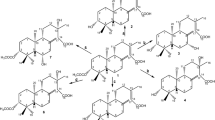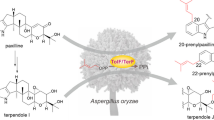Abstract
Epoxide hydrolases (EHs) are present in all living organisms and catalyze the hydrolysis of epoxides to the corresponding vicinal diols. EH are involved in the metabolism of endogenous and exogenous epoxides, and thus have application in pharmacology and biotechnology. In this work, we describe the substrates and inhibitors selectivity of an epoxide hydrolase recently cloned from the filamentous fungus Trichoderma reesei QM9414 (TrEH). We also studied the TrEH urea-based inhibitors effects in the fungal growth. TrEH showed high activity on radioative and fluorescent surrogate and natural substrates, especially epoxides from docosahexaenoic acid. Using a fluorescent surrogate substrate, potent inhibitors of TrEH were identified. Interestingly, one of the best compounds inhibit up to 60% of T. reesei growth, indicating an endogenous role for TrEH. These data make TrEH very attractive for future studies about fungal metabolism of fatty acids and possible development of novel drugs for human diseases.


Similar content being viewed by others
References
Morisseau C (2013) Role of epoxide hydrolases in lipid metabolism. Biochimie 95(1):91–95. https://doi.org/10.1016/j.biochi.2012.06.011
Morisseau C, Hammock BD (2005) Epoxide hydrolases: mechanisms, inhibitor designs, and biological roles. Annu Rev Pharmacol Toxicol 45:311–333. https://doi.org/10.1146/annurev.pharmtox.45.120403.095920
McGlynn KA, Rosvold EA, Lustbader ED, Hu Y, Clapper ML, Zhou T, Wild CP, Xia XL, Baffoe-Bonnie A, Ofori-Adjei D et al (1995) Susceptibility to hepatocellular carcinoma is associated with genetic variation in the enzymatic detoxification of aflatoxin B1. Proc Natl Acad Sci USA 92(6):2384–2387
Zhong JH, Zhang ZM, Li LQ (2013) mEH Tyr113His polymorphism and the risk of ovarian cancer development. J Ovarian Res 6(1):40. https://doi.org/10.1186/1757-2215-6-40
Huang WY, Chatterjee N, Chanock S, Dean M, Yeager M, Schoen RE, Hou LF, Berndt SI, Yadavalli S, Johnson CC, Hayes RB (2005) Microsomal epoxide hydrolase polymorphisms and risk for advanced colorectal adenoma. Cancer Epidemiol Biomark Prev 14(1):152–157
Kukkonen MK, Hamalainen S, Kaleva S, Vehmas T, Huuskonen MS, Oksa P, Vainio H, Piirila P, Hirvonen A (2011) Genetic polymorphisms of xenobiotic-metabolizing enzymes influence the risk of pulmonary emphysema. Pharmacogenet Genom 21(12):876–883. https://doi.org/10.1097/FPC.0b013e32834d597f
Lee CR, North KE, Bray MS, Fornage M, Seubert JM, Newman JW, Hammock BD, Couper DJ, Heiss G, Zeldin DC (2006) Genetic variation in soluble epoxide hydrolase (EPHX2) and risk of coronary heart disease: the Atherosclerosis Risk in Communities (ARIC) study. Hum Mol Genet 15(10):1640–1649. https://doi.org/10.1093/hmg/ddl085
Yu Z, Xu F, Huse LM, Morisseau C, Draper AJ, Newman JW, Parker C, Graham L, Engler MM, Hammock BD, Zeldin DC, Kroetz DL (2000) Soluble epoxide hydrolase regulates hydrolysis of vasoactive epoxyeicosatrienoic acids. Circ Res 87(11):992–998
Davis BB, Thompson DA, Howard LL, Morisseau C, Hammock BD, Weiss RH (2002) Inhibitors of soluble epoxide hydrolase attenuate vascular smooth muscle cell proliferation. Proc Natl Acad Sci USA 99(4):2222–2227. https://doi.org/10.1073/pnas.261710799
Schmelzer KR, Kubala L, Newman JW, Kim IH, Eiserich JP, Hammock BD (2005) Soluble epoxide hydrolase is a therapeutic target for acute inflammation. Proc Natl Acad Sci USA 102(28):9772–9777. https://doi.org/10.1073/pnas.0503279102
Inceoglu B, Wagner KM, Yang J, Bettaieb A, Schebb NH, Hwang SH, Morisseau C, Haj FG, Hammock BD (2012) Acute augmentation of epoxygenated fatty acid levels rapidly reduces pain-related behavior in a rat model of type I diabetes. Proc Natl Acad Sci USA 109(28):11390–11395. https://doi.org/10.1073/pnas.1208708109
Guedes AG, Morisseau C, Sole A, Soares JH, Ulu A, Dong H, Hammock BD (2013) Use of a soluble epoxide hydrolase inhibitor as an adjunctive analgesic in a horse with laminitis. Vet Anaesth Analg 40(4):440–448. https://doi.org/10.1111/vaa.12030
Madacki J, Laval F, Grzegorzewicz A, Lemassu A, Zahorszka M, Arand M, McNeil M, Daffe M, Jackson M, Laneelle MA, Kordulakova J (2018) Impact of the epoxide hydrolase EphD on the metabolism of mycolic acids in mycobacteria. J Biol Chem 293(14):5172–5184. https://doi.org/10.1074/jbc.RA117.000246
Biswal BK, Morisseau C, Garen G, Cherney MM, Garen C, Niu C, Hammock BD, James MN (2008) The molecular structure of epoxide hydrolase B from Mycobacterium tuberculosis and its complex with a urea-based inhibitor. J Mol Biol 381(4):897–912. https://doi.org/10.1016/j.jmb.2008.06.030
Spillman NJ, Dalmia VK, Goldberg DE (2016) Exported epoxide hydrolases modulate erythrocyte vasoactive lipids during Plasmodium falciparum infection. MBio. https://doi.org/10.1128/mBio.01538-16
Flitter BA, Hvorecny KL, Ono E, Eddens T, Yang J, Kwak DH, Bahl CD, Hampton TH, Morisseau C, Hammock BD, Liu X, Lee JS, Kolls JK, Levy BD, Madden DR, Bomberger JM (2017) Pseudomonas aeruginosa sabotages the generation of host proresolving lipid mediators. Proc Natl Acad Sci USA 114(1):136–141. https://doi.org/10.1073/pnas.1610242114
Druzhinina IS, Schmoll M, Seiboth B, Kubicek CP (2006) Global carbon utilization profiles of wild-type, mutant, and transformant strains of Hypocrea jecorina. Appl Environ Microbiol 72(3):2126–2133. https://doi.org/10.1128/AEM.72.3.2126-2133.2006
Zafra G, Cortes-Espinosa DV (2015) Biodegradation of polycyclic aromatic hydrocarbons by Trichoderma species: a mini review. Environ Sci Pollut Res Int 22(24):19426–19433. https://doi.org/10.1007/s11356-015-5602-4
Samuels GJ, Dodd SL, Gams W, Castlebury LA, Petrini O (2002) Trichoderma species associated with the green mold epidemic of commercially grown Agaricus bisporus. Mycologia 94(1):146–170
Komon-Zelazowska M, Bissett J, Zafari D, Hatvani L, Manczinger L, Woo S, Lorito M, Kredics L, Kubicek CP, Druzhinina IS (2007) Genetically closely related but phenotypically divergent Trichoderma species cause green mold disease in oyster mushroom farms worldwide. Appl Environ Microbiol 73(22):7415–7426. https://doi.org/10.1128/AEM.01059-07
Kuhls K, Lieckfeldt E, Borner T, Gueho E (1999) Molecular reidentification of human pathogenic Trichoderma isolates as Trichoderma longibrachiatum and Trichoderma citrinoviride. Med Mycol 37(1):25–33
Paredes K, Capilla J, Mayayo E, Guarro J (2016) Virulence and experimental treatment of Trichoderma longibrachiatum, a fungus refractory to treatment. Antimicrob Agents Chemother 60(8):5029–5032. https://doi.org/10.1128/AAC.00373-16
Myoken Y, Sugata T, Fujita Y, Asaoku H, Fujihara M, Mikami Y (2002) Fatal necrotizing stomatitis due to Trichoderma longibrachiatum in a neutropenic patient with malignant lymphoma: a case report. Int J Oral Maxillofac Surg 31(6):688–691. https://doi.org/10.1054/ijom.2001.0211
Druzhinina IS, Komon-Zelazowska M, Kredics L, Hatvani L, Antal Z, Belayneh T, Kubicek CP (2008) Alternative reproductive strategies of Hypocrea orientalis and genetically close but clonal Trichoderma longibrachiatum, both capable of causing invasive mycoses of humans. Microbiology 154(Pt 11):3447–3459. https://doi.org/10.1099/mic.0.2008/021196-0
Loeppky CB, Sprouse RF, Carlson JV, Everett ED (1983) Trichoderma viride peritonitis. South Med J 76(6):798–799
De Miguel D, Gomez P, Gonzalez R, Garcia-Suarez J, Cuadros JA, Banas MH, Romanyk J, Burgaleta C (2005) Nonfatal pulmonary Trichoderma viride infection in an adult patient with acute myeloid leukemia: report of one case and review of the literature. Diagn Microbiol Infect Dis 53(1):33–37. https://doi.org/10.1016/j.diagmicrobio.2005.04.009
Guiserix J, Ramdane M, Finielz P, Michault A, Rajaonarivelo P (1996) Trichoderma harzianum peritonitis in peritoneal dialysis. Nephron 74(2):473–474. https://doi.org/10.1159/000189374
Guarro J, Antolin-Ayala MI, Gene J, Gutierrez-Calzada J, Nieves-Diez C, Ortoneda M (1999) Fatal case of Trichoderma harzianum infection in a renal transplant recipient. J Clin Microbiol 37(11):3751–3755
Rota S, Marchesi D, Farina C, de Bievre C (2000) Trichoderma pseudokoningii peritonitis in automated peritoneal dialysis patient successfully treated by early catheter removal. Perit Dial Int 20(1):91–93
Gautheret A, Dromer F, Bourhis JH, Andremont A (1995) Trichoderma pseudokoningii as a cause of fatal infection in a bone marrow transplant recipient. Clin Infect Dis 20(4):1063–1064
Campos-Herrero M, Bordes A, Perera A, Ruiz M, Fernandez A (1996) Trichodermia koningii peritonitis in a patient undergoing peritoneal dialysis. Clin. Microbiol Newsl. 18(19):150–152
Ragnaud J, Marceau C, Roche-Bezian M, Wone C (1984) Infection peritoneale a Trichoderma koningii sur dialyse peritoneale continue ambulatoire. Médecine et maladies Infectieuses 14(7–8):402–405
de Oliveira GS, Adriani PP, Borges FG, Lopes AR, Campana PT, Chambergo FS (2016) Epoxide hydrolase of Trichoderma reesei: biochemical properties and conformational characterization. Int J Biol Macromol 89:569–574. https://doi.org/10.1016/j.ijbiomac.2016.05.031
Wilson C, De Oliveira GS, Adriani PP, Chambergo FS, Dias MVB (2017) Structure of a soluble epoxide hydrolase identified in Trichoderma reesei. Biochim Biophys Acta 1865(8):1039–1045. https://doi.org/10.1016/j.bbapap.2017.05.004
Pakula TM, Nygren H, Barth D, Heinonen M, Castillo S, Penttila M, Arvas M (2016) Genome wide analysis of protein production load in Trichoderma reesei. Biotechnol Biofuels 9:132. https://doi.org/10.1186/s13068-016-0547-5
Borhan B, Mebrahtu T, Nazarian S, Kurth MJ, Hammock BD (1995) Improved radiolabeled substrates for soluble epoxide hydrolase. Anal Biochem 231(1):188–200. https://doi.org/10.1006/abio.1995.1520
Jones PD, Wolf NM, Morisseau C, Whetstone P, Hock B, Hammock BD (2005) Fluorescent substrates for soluble epoxide hydrolase and application to inhibition studies. Anal Biochem 343(1):66–75. https://doi.org/10.1016/j.ab.2005.03.041
Morisseau C, Bernay M, Escaich A, Sanborn JR, Lango J, Hammock BD (2011) Development of fluorescent substrates for microsomal epoxide hydrolase and application to inhibition studies. Anal Biochem 414(1):154–162. https://doi.org/10.1016/j.ab.2011.02.038
Shen HC, Hammock BD (2012) Discovery of inhibitors of soluble epoxide hydrolase: a target with multiple potential therapeutic indications. J Med Chem 55(5):1789–1808. https://doi.org/10.1021/jm201468j
Morisseau C, Wecksler AT, Deng C, Dong H, Yang J, Lee KS, Kodani SD, Hammock BD (2014) Effect of soluble epoxide hydrolase polymorphism on substrate and inhibitor selectivity and dimer formation. J Lipid Res 55(6):1131–1138. https://doi.org/10.1194/jlr.M049718
Whitaker JR, Granum PE (1980) An absolute method for protein determination based on difference in absorbance at 235 and 280 nm. Anal Biochem 109(1):156–159
Morisseau C, Newman JW, Wheelock CE, Hill Iii T, Morin D, Buckpitt AR, Hammock BD (2008) Development of metabolically stable inhibitors of Mammalian microsomal epoxide hydrolase. Chem Res Toxicol 21(4):951–957. https://doi.org/10.1021/tx700446u
Morisseau C, Beetham JK, Pinot F, Debernard S, Newman JW, Hammock BD (2000) Cress and potato soluble epoxide hydrolases: purification, biochemical characterization, and comparison to mammalian enzymes. Arch Biochem Biophys 378(2):321–332. https://doi.org/10.1006/abbi.2000.1810
Wolf NM, Morisseau C, Jones PD, Hock B, Hammock BD (2006) Development of a high-throughput screen for soluble epoxide hydrolase inhibition. Anal Biochem 355(1):71–80. https://doi.org/10.1016/j.ab.2006.04.045
Morisseau C, Hammock BD (2013) Impact of soluble epoxide hydrolase and epoxyeicosanoids on human health. Ann Rev Pharmacol Toxicol 53:37–58
Bakan B, Marion D (2017) Assembly of the cutin polyester: from cells to extracellular cell walls. Plants 6(4):57
Xu DY, Davis BB, Wang ZH, Zhao SP, Wasti B, Liu ZL, Li N, Morisseau C, Chiamvimonvat N, Hammock BD (2013) A potent soluble epoxide hydrolase inhibitor, t-AUCB, acts through PPARgamma to modulate the function of endothelial progenitor cells from patients with acute myocardial infarction. Int J Cardiol 167(4):1298–1304. https://doi.org/10.1016/j.ijcard.2012.03.167
Shen L, Peng H, Zhao S, Xu D (2014) A potent soluble epoxide hydrolase inhibitor, t-AUCB, modulates cholesterol balance and oxidized low density lipoprotein metabolism in adipocytes in vitro. Biol Chem 395(4):443–451. https://doi.org/10.1515/hsz-2013-0251
Acknowledgements
This work was supported by National Institute of Environmental Health Sciences (Grant No. NIEHS-R01 ES002710), the Superfund Program NIEHS (Grant No. P42 ES 04699), and São Paulo Research Foundation (Grant Nos. FAPESP-2014/24107-1, 2017/25705-8). G.S.O. and P.P.A. is supported by a scholarship from FAPESP (Grant Nos. 2015/03329-9 and 2016/12859-4) and CNPq (142311/2016-2), respectively.
Author information
Authors and Affiliations
Corresponding author
Ethics declarations
Conflict of interest
The authors declare that they have no conflict of interest.
Ethical approval
This article does not contain any studies with human participants performed by any of the authors.
Electronic supplementary material
Below is the link to the electronic supplementary material.
Rights and permissions
About this article
Cite this article
de Oliveira, G.S., Adriani, P.P., Wu, H. et al. Substrate and inhibitor selectivity, and biological activity of an epoxide hydrolase from Trichoderma reesei. Mol Biol Rep 46, 371–379 (2019). https://doi.org/10.1007/s11033-018-4481-4
Received:
Accepted:
Published:
Issue Date:
DOI: https://doi.org/10.1007/s11033-018-4481-4




